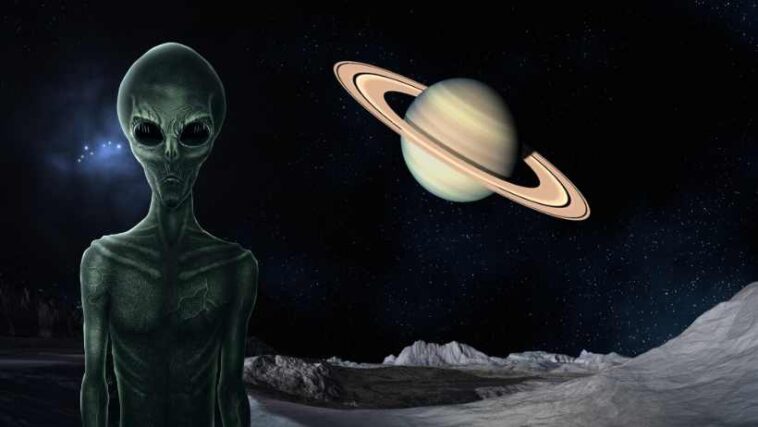If you ever stare at the night sky and wonder about the universe, Saturn’s moon Enceladus will captivate you. Unbelievable, new scientific findings suggest Enceladus may harbor alien life. You did indeed hear that correctly. Subterranean to the moon’s frigid exterior resides an oceanic bed of liquid water; the presence of organic molecules in the plumes of the moon has been identified, offering encouraging indications of life.
Due to the presence of methane and a combination of compounds capable of facilitating complex organic synthesis, Enceladus has the potential to become a flourishing ecosystem brimming with microorganisms. In order to ascertain the existence of life on Enceladus with certainty, additional missions and exploration are imperative. Those who are enthusiastic about investigating the marvels of the cosmos will soon be surrounded by memorable moments.
Enceladus: A Potential Habitat for Alien Life
The moon Enceladus, which is located on Saturn, has garnered significant attention from both space enthusiasts and scientists. The enigmatic plumes and frigid exterior of Enceladus have captivated our interest and fascination. This article examines scientific evidence that Enceladus may have alien life. Enceladus will be analyzed for organic compounds, life, and a subaqueous ocean. This study will aid the search for alien life.
The Exploration of Organic Molecules
Organic molecule detection is fundamental to the notion that extraterrestrials live on Enceladus. Organic compounds—carbon and hydrogen—form the basis of life. Scientists found these chemicals in lunar vapors, suggesting life-supporting circumstances.
Life Indicators on Enceladus
Enceladus has several intriguing signs of life. One sign is the presence of phosphates, which are essential to the production of DNA and RNA, which store genetic information. Methane, hydrogen, and carbon dioxide may indicate lunar life. Extraterrestrial life research relies on methane.
Liquid Ocean Water
Underneath its frigid exterior, Enceladus conceals an ocean of liquid water. The validation of this subterranean ocean has exacerbated conjecture regarding the possibility of life existing on the moon. Water is a fundamental component for all life on our planet, and the presence of a liquid water ocean creates the potential for microbial life to flourish.
Constituents of Plumes
The diagnostic emissions that emerge from Enceladus’ surface offer significant insights into the planet’s capacity to harbor extraterrestrial life. A multitude of substances, including hydrogen cyanide, acetylene, propylene, and ethane, are contained within these emissions. Additionally, minute quantities of molecular oxygen and alcohol have been identified. Complex organic synthesis may be possible under the conditions present on Enceladus, as indicated by the presence of these compounds.
Assistance with Organic Synthesis
The chemical constituents discovered in the plumes of Enceladus carry substantial ramifications for biosynthesis. As an illustration, hydrogen cyanide is a precursor molecule that is essential for the synthesis of amino acids, which are the fundamental components of proteins. The existence of acetylene and additional hydrocarbons indicates the possibility of organic molecule formation involving greater complexity. This intriguing notion suggests that Enceladus might have served as the primordial environment for life, given its favorable conditions for organic synthesis.
The Potential for Microbial Life
Methane on Enceladus may be an indicator for microbial life, which intrigues scientists. Since Earth’s microbes produce methane, Enceladus’ methane may indicate the presence of its own life forms. Microbial life may thrive in Enceladus’ subterranean environments, which are rich in water and critical chemicals and sheltered from severe radiation.
Missions and exploration that are vital
In order to ascertain the existence of extraterrestrial life on Enceladus with absolute certainty, additional missions and exploration are imperative. The development and deployment of instruments capable of detecting and analyzing the compounds in the aerosols is required on the moon. The investigation of Enceladus’ emissions will enable scientists to collect vital information regarding the planet’s composition and life potential. An examination and sampling of the emissions will yield significant knowledge regarding the organic compounds that are present.
To determine Enceladus’ habitability for alien life, future space journeys should gather and experiment with samples.
In conclusion, Saturn’s moon Enceladus might support alien life. The evidence of organic molecules, life, and a liquid-water ocean is growing.
The support for organic synthesis provided by the plume composition lends credence to the notion that Enceladus might serve as a potential habitat for life. The discovery of methane, which suggests the potential existence of microbes, adds to the already intense curiosity surrounding this moon.
However, further exploration and mission-building are required to validate these results and ascertain the existence of life on Enceladus. With the advancement of knowledge regarding this mysterious moon, our optimism regarding the potential identification of extraterrestrial life increases.



